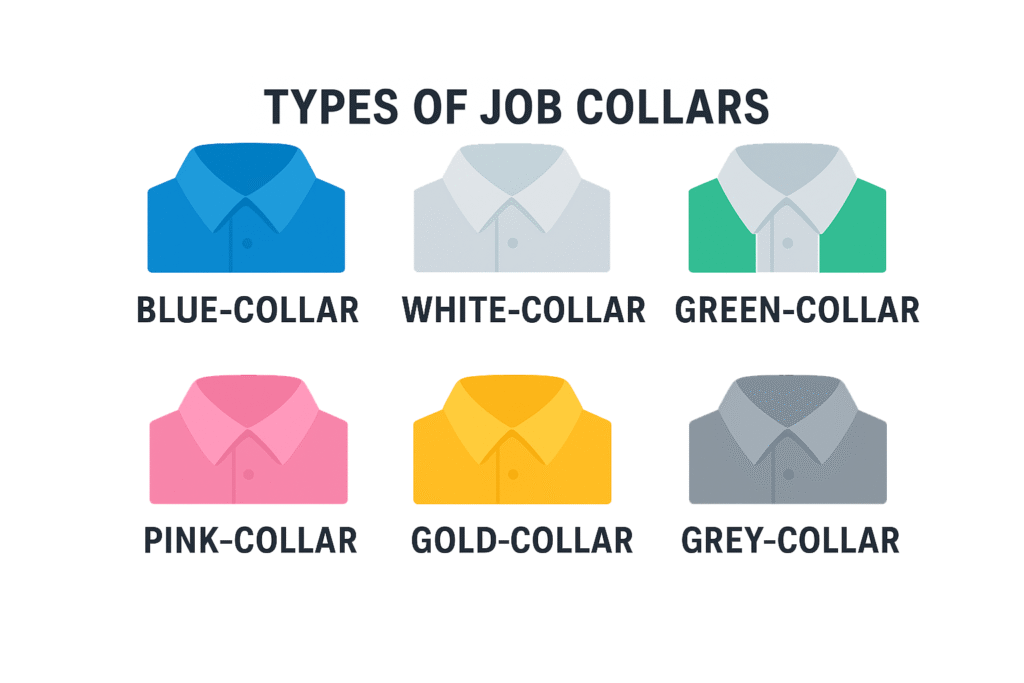The modern workforce is incredibly diverse, and one of the most insightful ways to understand it is through the concept of job collars. The “collar” classification system represents different categories of occupations based on the type of work, required education, and the skills involved. While most people are familiar with blue-collar (manual labor) and white-collar (office-based professional) work, many more classifications—like green-collar, pink-collar, gold-collar, and grey-collar—have evolved to reflect changes in technology, sustainability, and the economy.
By studying job collars, job seekers, employers, and policymakers gain a better perspective on workforce dynamics, career requirements, and future trends.
Types of Job Collars
1. Blue-Collar Jobs
- Definition: Blue-collar jobs are rooted in manual labor and skilled trades. They often involve physical work and the use of tools, machinery, or hands-on techniques.
- Fields Represented: Construction, manufacturing, electrical work, plumbing, automotive repair, welding, transportation, and logistics.
- Education Requirements:
- Typically requires a high school diploma or GED.
- Many roles rely on vocational training, apprenticeships, or trade certifications.
- Some technical roles may need postsecondary certifications (e.g., HVAC, mechanics).
- Skills Required:
- Technical expertise with machinery and tools.
- Physical stamina, dexterity, and attention to detail.
- Problem-solving skills for on-the-job challenges.
- Strong understanding of safety standards and regulations.
- Examples: Electricians, carpenters, truck drivers, mechanics, welders.
2. White-Collar Jobs
- Definition: White-collar jobs are primarily professional, managerial, or administrative roles. They are often performed in offices and focus more on knowledge work than physical labor.
- Fields Represented: Finance, law, corporate management, consulting, education, healthcare administration, IT, and research.
- Education Requirements:
- A college degree (associate’s or bachelor’s) is standard for most entry-level roles.
- Advanced positions often demand master’s or professional degrees (MBA, JD, MD, etc.).
- Continuous professional certifications (CPA, CFA, PMP, etc.) are common.
- Skills Required:
- Analytical thinking, problem-solving, and strategic decision-making.
- Strong written and verbal communication.
- Leadership and management abilities.
- Digital literacy, including data analysis and software proficiency.
- Examples: Accountants, lawyers, consultants, managers, IT professionals, teachers.
3. Green-Collar Jobs
- Definition: Green-collar jobs are tied to environmental sustainability, renewable energy, and conservation. They are growing in demand as climate change and clean energy take center stage in global policies.
- Fields Represented: Renewable energy (solar, wind), sustainable construction, waste management, conservation, environmental engineering, and green technology innovation.
- Education Requirements:
- Varies widely depending on the role.
- Entry-level jobs (like solar installation) may require only certifications or technical training.
- Advanced roles (like environmental scientists or engineers) often require bachelor’s or master’s degrees.
- Skills Required:
- Knowledge of renewable energy systems, sustainable practices, and environmental science.
- Problem-solving with a focus on innovation.
- Technical and project management expertise.
- Adaptability to evolving green technologies.
- Examples: Solar panel technicians, wind turbine engineers, environmental scientists, sustainability officers.
4. Pink-Collar Jobs
- Definition: Pink-collar jobs are service-oriented and often associated with caregiving, customer interaction, and traditionally female-dominated industries.
- Fields Represented: Nursing, teaching, hospitality, retail, administrative assistance, childcare, cosmetology.
- Education Requirements:
- Some jobs (e.g., waitstaff, clerical roles) require only on-the-job training.
- Others, like nursing or teaching, need specialized certifications, associate’s degrees, or bachelor’s degrees.
- Continuous training is common due to fast-changing industry standards.
- Skills Required:
- Strong interpersonal and communication skills.
- Emotional intelligence and empathy.
- Organizational and multitasking ability.
- Customer service orientation.
- Examples: Nurses, teachers, secretaries, receptionists, retail associates, childcare workers.
5. Gold-Collar Jobs
- Definition: Gold-collar jobs represent highly skilled, specialized professions that require advanced education and expertise. They are typically prestigious and high-paying.
- Fields Represented: Medicine, engineering, law, advanced technology (AI, data science), finance, and corporate leadership.
- Education Requirements:
- Almost always require advanced degrees (MD, JD, Ph.D., MBA).
- Extensive professional training and continuous certifications are standard.
- Many involve long academic paths (e.g., 7–10 years for surgeons).
- Skills Required:
- Specialized technical or medical expertise.
- Leadership and decision-making.
- Innovation, critical thinking, and problem-solving at a high level.
- Ability to work under pressure and manage high-stakes situations.
- Examples: Surgeons, corporate lawyers, AI engineers, data scientists, investment bankers.
6. Grey-Collar Jobs
- Definition: Grey-collar jobs sit at the intersection of blue-collar and white-collar roles. They often involve supervisory or technical positions that require both practical skills and administrative responsibilities.
- Fields Represented: Law enforcement, healthcare technicians, IT support, first responders, supervisors in skilled trades.
- Education Requirements:
- Often require associate’s or bachelor’s degrees.
- Technical certifications or specialized training (like EMT or law enforcement academies) are common.
- Experience is often weighted heavily in career progression.
- Skills Required:
- Technical expertise in the relevant field.
- Leadership and team management.
- Problem-solving with a blend of theory and practice.
- Ability to adapt between physical and administrative tasks.
- Examples: Police officers, paramedics, IT technicians, healthcare administrators, fire marshals.
Other Classifications of Job Collars
In addition to the six major categories, several other “collar” types exist in modern workforce discussions:
- Black-Collar Jobs: Workers in dangerous or hazardous industries such as mining, oil drilling, or the military.
- Red-Collar Jobs: Government workers and public administrators, often symbolizing the bureaucratic side of labor.
- New-Collar Jobs: Emerging tech-focused roles (cybersecurity, data analytics, cloud computing) that don’t always require traditional degrees but demand certifications and digital skills.
- Open-Collar Jobs: Freelancers, remote workers, and gig economy professionals who thrive in flexible, technology-driven environments.
Which Job Collar Suits You? Career Guidance
Choosing a career path is about more than just salary or status — it’s about aligning your skills, education, and interests with the right type of work. Here’s a quick guide to help you identify which job collar may suit you best:
Blue-Collar: Hands-On Problem Solvers
- Best For: People who enjoy working with their hands, solving practical problems, and seeing immediate results from their work.
- You’ll Thrive If: You value skilled craftsmanship, physical activity, and job stability in essential trades.
- Pathways: Trade schools, apprenticeships, and certifications.
White-Collar: Knowledge and Strategy Experts
- Best For: Those who prefer office settings, data-driven decision-making, and working in professional industries.
- You’ll Thrive If: You enjoy analytical work, management, or business growth.
- Pathways: College degrees, professional certifications, and leadership training.
Green-Collar: Sustainability Advocates
- Best For: People passionate about the environment, clean energy, and innovation in sustainability.
- You’ll Thrive If: You want a career with a purpose, contributing to renewable energy and conservation efforts.
- Pathways: Environmental studies, renewable energy certifications, STEM degrees.
Pink-Collar: Service and Care Champions
- Best For: Empathetic, patient, and people-oriented individuals who want to make a difference in people’s lives.
- You’ll Thrive If: You enjoy helping, teaching, or supporting others in their daily lives.
- Pathways: Nursing programs, teaching degrees, hospitality training.
Gold-Collar: Specialists and High Achievers
- Best For: Ambitious professionals seeking challenging, high-paying roles with significant responsibility.
- You’ll Thrive If: You enjoy intellectual challenges, leadership, and pushing the limits of knowledge.
- Pathways: Medical school, law school, advanced STEM programs, MBAs, PhDs.
Grey-Collar: The Hybrid Professionals
- Best For: People who want to balance hands-on technical work with administrative or supervisory duties.
- You’ll Thrive If: You’re adaptable, versatile, and comfortable moving between technical and leadership roles.
- Pathways: Associate’s or bachelor’s degrees, specialized certifications, career advancement through experience.
Frequently Asked Questions (FAQs) About Job Collars
1. Why are jobs classified by “collars”?
Jobs are classified by collars to symbolize the nature of the work, education requirements, and workplace environments. Originally, blue-collar and white-collar reflected workers’ typical clothing, but the classification has since expanded to represent broader career categories.
2. Which collar jobs usually pay the most?
Gold-collar jobs typically offer the highest salaries because they require advanced education, long years of training, and highly specialized skills. Examples include surgeons, corporate lawyers, and data scientists. However, some blue-collar trades (like electricians or oil rig workers) can also be very lucrative due to high demand and specialized expertise.
3. Are blue-collar jobs being replaced by technology?
Automation and AI have changed many blue-collar roles, particularly in manufacturing. However, jobs that require hands-on technical expertise (plumbing, electrical work, HVAC, construction) remain in high demand and are less likely to be fully replaced by machines.
4. Which collar jobs are growing the fastest?
Currently, green-collar and new-collar jobs are experiencing the fastest growth. Renewable energy, sustainability, and technology fields such as cybersecurity and data analysis are driving this expansion.
5. Do all white-collar jobs require a college degree?
Not always. While many white-collar professions do require at least a bachelor’s degree, some entry-level office roles may only require certifications, associate’s degrees, or relevant experience. Additionally, new-collar tech jobs often rely more on skill-based certifications than traditional degrees.
6. What is the difference between grey-collar and white-collar jobs?
Grey-collar jobs combine elements of blue- and white-collar work. For example, a healthcare technician may use hands-on technical skills (blue-collar aspect) while also managing patient records or supervising teams (white-collar aspect). White-collar jobs, by contrast, are primarily administrative or professional in nature.
7. How do pink-collar jobs fit into today’s workforce?
Pink-collar jobs have evolved from being associated only with traditional service roles (like secretaries or caregivers) to a much wider range of service and customer-facing industries. Many pink-collar jobs, especially in healthcare and education, are essential and in high demand.
8. Can a person move from one collar category to another?
Yes. Career transitions are increasingly common. For example, a blue-collar electrician might gain certifications and move into a grey-collar supervisory role, or a pink-collar nurse might pursue advanced education to enter a gold-collar medical specialty. Lifelong learning makes such transitions possible.
9. Are “collar” classifications officially recognized by governments or employers?
Not formally. Collar terms are more of a sociological and cultural framework rather than an official classification system. They are used in academic studies, workforce discussions, and media to describe trends and career paths.
10. What is the future of job collars?
The future will likely see more hybrid collars emerge as technology, remote work, and sustainability reshape industries. For example, new-collar jobs (tech-driven but non-degree-based) may become one of the most influential categories in the global workforce.
Final Thoughts
The classification of jobs by collars helps simplify the vast world of work. From blue-collar trades that keep industries moving, to gold-collar specialists pushing innovation, each collar has unique educational pathways and skill demands. As industries evolve—especially with technology and sustainability—new job collars are likely to emerge, making lifelong learning and adaptability more important than ever.
For professionals, knowing where a job falls in this spectrum can help shape career choices, training investments, and skill development. For employers and educators, it provides clarity in designing workforce strategies to meet future labor market needs.






